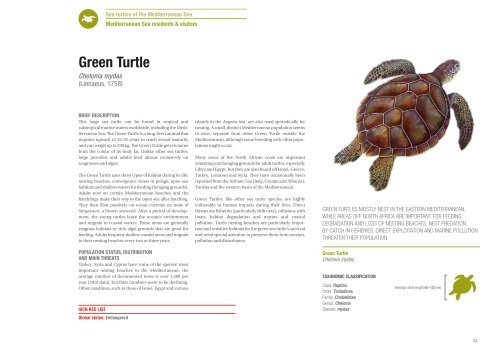Marine mammals and sea turtles of the Mediterranean and ... - IUCN
Marine mammals and sea turtles of the Mediterranean and ... - IUCN
Marine mammals and sea turtles of the Mediterranean and ... - IUCN
You also want an ePaper? Increase the reach of your titles
YUMPU automatically turns print PDFs into web optimized ePapers that Google loves.
Sea <strong>turtles</strong> <strong>of</strong> <strong>the</strong> <strong>Mediterranean</strong> Sea<br />
<strong>Mediterranean</strong> Sea residents & visitors<br />
Green Turtle<br />
Chelonia mydas<br />
(Linnaeus, 1758)<br />
BRIEF DESCRIPTION<br />
This large <strong>sea</strong> turtle can be found in tropical <strong>and</strong><br />
subtropical marine waters worldwide, including <strong>the</strong> <strong>Mediterranean</strong><br />
Sea. The Green Turtle is a long-lived animal that<br />
requires upward <strong>of</strong> 25-35 years to reach sexual maturity<br />
<strong>and</strong> can weigh up to 230 kg. The Green Turtle gets its name<br />
from <strong>the</strong> colour <strong>of</strong> its body fat. Unlike o<strong>the</strong>r <strong>sea</strong> <strong>turtles</strong>,<br />
large juveniles <strong>and</strong> adults feed almost exclusively on<br />
<strong>sea</strong>grasses <strong>and</strong> algae.<br />
The Green Turtle uses three types <strong>of</strong> habitat during its life:<br />
nesting beaches, convergence zones in pelagic open-<strong>sea</strong><br />
habitats <strong>and</strong> shallow waters for feeding (foraging grounds).<br />
Adults nest on certain <strong>Mediterranean</strong> beaches <strong>and</strong> <strong>the</strong><br />
hatchlings make <strong>the</strong>ir way to <strong>the</strong> open <strong>sea</strong> after hatching.<br />
They <strong>the</strong>n float passively on ocean currents on mats <strong>of</strong><br />
Sargassum, a brown <strong>sea</strong>weed. After a period <strong>of</strong> development,<br />
<strong>the</strong> young <strong>turtles</strong> leave <strong>the</strong> oceanic environment<br />
<strong>and</strong> migrate to coastal waters. These areas are generally<br />
<strong>sea</strong>grass habitats or rich algal grounds that are good for<br />
feeding. Adults frequent shallow coastal areas <strong>and</strong> migrate<br />
to <strong>the</strong>ir nesting beaches every two or three years.<br />
POPULATION STATUS, DISTRIBUTION<br />
AND MAIN THREATS<br />
Turkey, Syria <strong>and</strong> Cyprus have some <strong>of</strong> <strong>the</strong> species’ most<br />
important nesting beaches in <strong>the</strong> <strong>Mediterranean</strong>; <strong>the</strong><br />
average number <strong>of</strong> documented nests is over 1,500 per<br />
year (2010 data), but <strong>the</strong>ir numbers seem to be declining.<br />
O<strong>the</strong>r coastlines, such as those <strong>of</strong> Israel, Egypt <strong>and</strong> various<br />
<strong>IUCN</strong> RED LIST<br />
Global status: Endangered<br />
isl<strong>and</strong>s in <strong>the</strong> Aegean Sea, are also used sporadically for<br />
nesting. A small, distinct <strong>Mediterranean</strong> population seems<br />
to exist, separate from o<strong>the</strong>r Green Turtle outside <strong>the</strong><br />
<strong>Mediterranean</strong>, although some breeding with o<strong>the</strong>r populations<br />
might occur.<br />
Many areas <strong>of</strong> <strong>the</strong> North African coast are important<br />
wintering <strong>and</strong> foraging grounds for adult <strong>turtles</strong>, especially<br />
Libya <strong>and</strong> Egypt, but <strong>the</strong>y are also found <strong>of</strong>f Israel, Greece,<br />
Turkey, Lebanon <strong>and</strong> Syria. They have occasionally been<br />
reported from <strong>the</strong> Adriatic Sea (Italy, Croatia <strong>and</strong> Albania),<br />
Tunisia <strong>and</strong> <strong>the</strong> western basin <strong>of</strong> <strong>the</strong> <strong>Mediterranean</strong>.<br />
Green Turtles, like o<strong>the</strong>r <strong>sea</strong> turtle species, are highly<br />
vulnerable to human impacts during <strong>the</strong>ir lives. Direct<br />
threats are fisheries (particularly drift nets), collisions with<br />
boats, habitat degradation <strong>and</strong> marine <strong>and</strong> coastal<br />
pollution. Turtle nesting beaches are particularly important<br />
<strong>and</strong> sensitive habitats for <strong>the</strong> green <strong>sea</strong> turtle’s survival<br />
<strong>and</strong> need special attention to preserve <strong>the</strong>m from erosion,<br />
pollution <strong>and</strong> disturbance.<br />
GREEN TURTLES MOSTLY NEST IN THE EASTERN MEDITERRANEAN,<br />
WHILE AREAS OFF NORTH AFRICA ARE IMPORTANT FOR FEEDING.<br />
DEGRADATION AND LOSS OF NESTING BEACHES, NEST PREDATION,<br />
BY-CATCH IN FISHERIES, DIRECT EXPLOITATION AND MARINE POLLUTION<br />
THREATEN THEIR POPULATION<br />
Green Turtle<br />
Chelonia mydas<br />
TAXONOMIC CLASSIFICATION<br />
Class: Reptilia<br />
Order: Testudines<br />
Family: Cheloniidae<br />
Genus: Chelonia<br />
Species: mydas<br />
Average adult length 80–120 cm<br />
23.

















